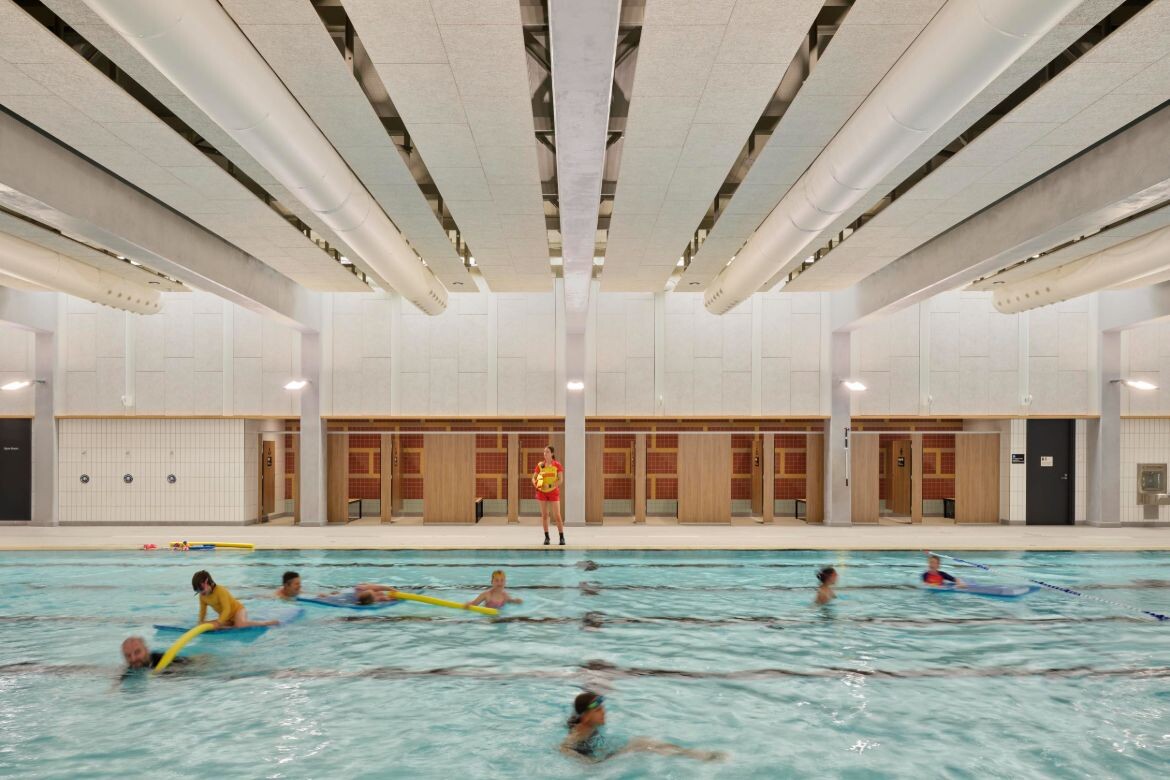With Sydney poised to potentially see a massive new $2bn stadium project, we take a look at 10 architecturally impressive examples of stadium design we might take inspiration from…
January 17th, 2018
Stadium design – it’s something every sports fan experiences and perhaps has issue with, but rarely is it seen as the star. In a recent controversial move, the NSW State Government is poised to potentially destroy and rebuild the ANZ and Allianz stadiums in a huge $2bn project. If this does go ahead, the resulting stadium design should be something the city of Sydney, and Australia in general can be proud of. With this in mind, here are 10 examples of stadium design we might look to for inspiration.
Taking the Chinese city of Guangzhou’s nickname, the Flower City, as inspiration, the Guangdong Olympic Stadium is an inspiring effort that merged architectural beauty with practical design. American firm Ellerbe Becket designed the stadium with a sunscreen roof to resemble layers of petals on a flower. The design firm stated in its press release: “The stadium bowl grows out of the ground to a sculpted upper edge, like the petals of a flower. Floating above the bowl is a shimmering ribbon of roof flowing like a wave over the seats. It parts at the ends and holds the Olympic flame, suspended between the two ribbons. A hotel surrounds a circular opening in the roof that forms a vertical tower of light, which at night is visible for a great distance”
Designed by legendary Japanese architect Hiroshi Hara, the Sapporo Dome is a masterclass in designing for locale. The dome itself has been designed to be an attractive site from near or afar, but also allow the near 20 feet of snow the northern Japanese city averages each year to slide off of the roof easily, lessening the stress on the structure. Plus, dome switches between two entirely different surfaces, with baseball games played on an underlying artificial turf field and association football games played on a grass pitch that slides in and out of the stadium as needed. While the concerns for snow are perhaps not so relevant for Sydney – the care taken for designing in relation to its space and use is a message useful for all design.
A stunning example of stadium design, the First National Bank Stadium, better know as Soccer City, is the crown jewel in African stadium design. The outside of the stadium has been designed to recall the appearance of traditional African pottery, with the cladding seen as a mosaic of fire and earthen colours with a ring of lights running around the bottom of the structure, simulating fire underneath the pot. And with no spectator seated more than 100 metres from the field, there are no restricted views throughout.
A controversial choice perhaps? The equally loved and underwhelming London Stadium, designed for the 2012 Olympics, nonetheless has a lot of lessons for Sydney’s next stadium design. While somewhat utilitarian in design, it still demonstrates a real interest in establishing an economy of means and stands as a stadium firmly in favour of sustainable development. The dismountable nature of the stadium means multipurpose has never been easier, which is why West Ham United can easily call the stadium home today.
The Bird’s Nest, as it has become popularly known, is one of the most popular and acclaimed examples of contemporary stadium design. Designed and launched for the 2008 Olympics, the massive project (jointly designed by Herzog & de Meuron, architect Stefan Marbach, artist Ai Weiwei, and CADG) does away with extraneous finishes, leaving only the exposed steel structures of the project, which gives the massive arena its nickname – a big nest that embraces and nurses those visiting. Though perhaps a cradle is a better moniker, bearing hope and growth for the future.
Munich’s groundbreaking stadium, also known as the Fußball Arena München has been impressing design aficionados and sports fans alike since opening in 2005. Widely known for its unique exterior composed of inflated ETFE plastic panels, it is the first stadium in the world with a full colour-changing exterior. While the world-class interior has been lauded and deservingly used for some of Europe’s top football matches, it is this exterior for which the stadium is most acclaimed. Uniquely, each panel can be independently lit with white, red, or blue lights – which means home team colours, national flags and logos can be emblazoned on the outside – visible up to 80km away.
Does Munich just have all the luck? Wildly different to the Alliance Arena, the Olympiapark is more than just a simple stadium – and with a suspected $2bn budget, maybe that’s the kind of stadium design Sydney needs. The Olympic level park is split across four major structures, with the concept of a “green Olympic Games” channelled across all, and integrated with optimistic design toward the future with a positive attitude toward technology. Finished with an eye-catching tensile structure that covers much of the park, designed by the late Pritzker prize-winning architect Frei Otto, Olympiapark is one of the longest lasting examples of brilliant stadium design.
Good stadium design has to be more than just eye-catching. And while the National Stadium of Taiwan is certainly a spectacular building to look it, it is really elevated to another level when you realise that the stadium, designed by Japanese architect Toyo Ito, is covered in, and powered by, solar panels. The stadium’s semi-spiral, dragon-shaped design is the first stadium in the world to provide near exclusive power using solar power technology. Not only that, when not in use, the stadium actually has energy to return to the grid. If Sydney is to have a massive new stadium built, perhaps this is the most sensible path to go down.
Besides boasting a spectacular view of the Cerra de la Silla mountain, Monterrey’s Estadio BBVA Bancomer, nicknamed “El Gigante de Acero” (Spanish for “The Steel Giant”), is a beautiful example of contemporary stadium design with an environmental bent. With more than a third of the total land area being green, these green areas are used to filter rainwater that will contribute to the recharge of local aquifers.
Ireland’s Aviva Stadium stands among the top sustainable and site-responsive stadiums in the world – and was recognised as such in 2011 when it received the Emirates Glass LEAF Award. The undulating wave-like roof, differing in heights in the north and south, along with a transparent façade avoid blockage of sunlight on the adjacent residences and nearby Lansdowne Road. The façade itself provides a beautiful shimmering effect to the stadium, by reflecting the patterns and clouds in the sky and differing light conditions.
INDESIGN is on instagram
Follow @indesignlive
A searchable and comprehensive guide for specifying leading products and their suppliers
Keep up to date with the latest and greatest from our industry BFF's!

To honour Chef James Won’s appointment as Gaggenau’s first Malaysian Culinary Partner, we asked the gastronomic luminaire about parallels between Gaggenau’s ethos and his own practice, his multidimensional vision of Modern Malaysian – and how his early experiences of KFC’s accessible, bold flavours influenced his concept of fine dining.

BLANCOCULINA-S II Sensor promotes water efficiency and reduces waste, representing a leap forward in faucet technology.

Elevate any space with statement lighting to illuminate and inspire.

In design, the concept of absence is particularly powerful – it’s the abundant potential of deliberate non-presence that amplifies the impact of what is. And it is this realm of sophisticated subtraction that Gaggenau’s Dishwasher 400 Series so generously – and quietly – occupies.

Designed with culture and meaning, Casuarina Pavilion is a jewel in the crown of Melbourne city and a place where everyone can come together to celebrate Country.

Dreamily poetic in his approach to any project, Joe Cheng, director of CCD and UN Cultural Ambassador, has adopted the Fenghuang as the thematic touchstone for Shangri-La Nanshan.
The internet never sleeps! Here's the stuff you might have missed

We spoke to the Belgian architect about his work ‘Optô,’ which was on display as part of the exhibition ‘Poetica’ by WonderGlass at Milan Design Week 2025.

Kerrie Shepherd is a Kamilaroi woman and Principal of Connecting with Country at Aboriginal-owned urban design company Yerrabingin, drawing on extensive lived experience with First Nations communities.

Carnegie Memorial Swimming Pool by CO.OP Studio is supposedly Australia’s most sustainable aquatic centre.

Jeremy Bull, Principal of Alexander &Co., brings a deeply personal and human-centred approach to architecture and design. In this Speaking Out! interview for the 2025 INDE.Awards, supported by MillerKnoll, Jeremy reflects on his practice’s evolution, his childhood influences and the creation of Alexander House – a project that redefined the idea of a modern workplace.